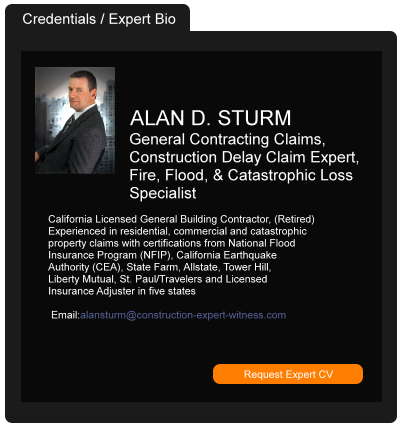Eleventh Circuit’s Noteworthy Discussion on Bad Faith Insurance Claims
November 01, 2021 —
David Adelstein - Florida Construction Legal UpdatesThe Eleventh Circuit Court of Appeal’s opinion in Pelaez v. Government Employees Insurance Company, 2021 WL 4258821 (11th Cir. 2021) is a non-construction case that discusses the standard for pursuing a bad faith claim against an insurer. This case dealt with an automobile accident. While the facts of the case are interesting and will be discussed, the takeaway is the Eleventh Circuit’s noteworthy discussion on the standard for bad faith claims and how they should be evaluated. This discussion is included below–with citations–because while the term “bad faith” is oftentimes thrown around when it comes to insurance carriers, there is indeed an evaluative standard that is applied to determine whether an insurance carrier acted in bad faith.
In Pelaez, a high school student driving a car crashed with a motorcycle. The motorcycle driver was seriously injured and airlifted to the hospital. The accident was reported to the automobile liability insurer of the driver of the car. The insurer through its investigation initially believed the motorcycle driver was contributory negligent. Eleven days after the crash, after learning additional information, the insurer tendered its bodily injury policy limits of $50,00 to the motorcycle driver even though it never received a settlement demand. The insurer sent a tender package to the motorcycle driver’s lawyer that included a $50,000 check for the bodily injury claim and a proposed release. The accompanying letter told the attorney to contact the insurer with any questions about the release and to edit the proposed release with suggested changes. The insurer also wanted to inspect the motorcycle in furtherance of adjusting the property damage claim which also had a policy limit of $50,000. A location of where the motorcycle could be inspected was never provided.
Read the court decisionRead the full story...Reprinted courtesy of
David Adelstein, Kirwin Norris, P.A.Mr. Adelstein may be contacted at
dma@kirwinnorris.com
General Liability Alert: ADA Requirements Pertaining to Wall Space Adjacent to Interior Doors Clarified
February 26, 2015 —
Lawrence S. Zucker II and Kristian B. Moriarty – Haight Brown & Bonesteel LLPIn Kohler v. Bed Bath & Beyond (No. 12-56727, filed February 19, 2015) the United States Court of Appeals for the Ninth Circuit affirmed a grant of summary judgment in favor of a department store related to the necessary moving clearance for an interior restroom door pursuant to the Americans With Disabilities Act ("ADA").
Plaintiff, Chris Kohler, is paraplegic and requires the use of a wheelchair to move in public. On two separate days in May 2011, Kohler used the restroom inside the Bed Bath & Beyond store in Riverside, California. Of relevance to the appeal, Kohler contends there was less than ten inches of strike-side wall space on the pull side of Bed Bath & Beyond’s restroom door which allegedly made it difficult for Mr. Kohler to pull open the restroom door by pushing off the strike-side wall with one hand while pulling the door handle with the other. He also contends there was less than three inches of strike-side wall or floor space on the push side of the door, making it difficult for Kohler to open the door from the push side. The door at issue did not have a latch which would stop the door from freely swinging on a hinge.
Reprinted courtesy of
Lawrence S. Zucker II, Haight Brown & Bonesteel LLP and
Kristian B. Moriarty, Haight Brown & Bonesteel LLP
Mr. Zucker may be contacted at lzucker@hbblaw.com
Mr. Moriarty may be contacted at kmoriarty@hbblaw.com
Read the court decisionRead the full story...Reprinted courtesy of
Be Careful with “Green” Construction
March 18, 2019 —
Christopher G. Hill - Construction Law MusingsAs readers of Construction Law Musings can attest, I am an enthusiastic (if at times skeptical) supporter of sustainable (or “green”) building. I am solidly behind the environmental and other benefits of this type of construction. However, I have likened myself to that loveable donkey Eeyore on more than one occasion when discussing the headlong charge to a sustainable future. While I see the great benefits of a privately built and privately driven marketplace for sustainable (I prefer this term to “green” because I find it less ambiguous) building stock and retrofits of existing construction, I have felt for a while that the glory of the goal has blinded us somewhat to the risks and the need to consider these risks as we move forward.
Another example reared it’s ugly head recently and was pointed out by my pal Doug Reiser (@douglasreiser) at his Builders Counsel Blog (a great read by the way). Doug describes a project that I mentioned previously here at Musings and that is well described in his blog and in a recent newsletter from Stuart Kaplow (@stuartkaplow), namely, the Chesapeake Bay Foundation’s Philip Merrill Environmental Center project. I commend Doug’s post for a great description of the issues, but suffice it to say that the Chesapeake Bay Foundation sued Weyerhauser over some issues with a sustainable wood product that failed. While the case was dismissed on statute of limitations grounds, the case illustrates issues that arise in the “new” sustainable building world.
Read the court decisionRead the full story...Reprinted courtesy of
The Law Office of Christopher G. HillMr. Hill may be contacted at
chrisghill@constructionlawva.com
The Buck Stops Over There: Have Indemnitors Become the Insurers of First and Last Resort?
September 17, 2015 —
Garret Murai – California Construction Law BlogInsurance and indemnity are the primary risk management strategies on construction projects. Insurance, such as commercial general liability insurance, insures against third party claims for bodily injury and property damage, and in the case of builder’s risk insurance, insures against first party claims during construction.
Indemnity, on the other hand, shifts liability from one party to another and can be broader than the types of claims covered by insurance although anti-indemnity statutes can limit the breadth of those claims.
Sometimes though insurance and indemnity work in ways you might never have expected, like in the next case, Valley Crest Landscape Development, Inc. v. Mission Pools of Escondido, Inc., Case No. G049060 (July 2, 2015), in which the California Court of Appeals for the Fourth District held a subcontractor liable in the face of both an indemnity claim brought by a general contractor as well as a subrogation claim brought by the general contractor’s insurance company.
Read the court decisionRead the full story...Reprinted courtesy of
Garret Murai, Wendel Rosen Black & Dean LLPMr. Murai may be contacted at
gmurai@wendel.com
Cross-Office Team Secures Defense Verdict in Favor of Client in Asbestos Case
November 18, 2024 —
Lewis Brisbois NewsroomSt. Louis/Kansas City, Mo. (October 23, 2024) - St. Louis Partners Tracy J. Cowan and Karen M. Volkman, along with Kansas City Partner Vincent Gunter, secured a defense verdict in a Jackson County, Missouri matter on behalf of a Lewis Brisbois client, which was the successor-in-interest to a life, health and reinsurance firm, against claims brought by an individual who worked in the corporate headquarters and was diagnosed with mesothelioma.
Background
The plaintiff was 62 years old when she was diagnosed with mesothelioma. She worked as a clerk for several years in the 1970s in a 19-story office building that opened in 1963. The plaintiff claimed construction work being performed in the areas where she worked exposed her to asbestos from above the suspended ceiling. The beams and girders in the building were fireproofed with sprayed-on insulation. Although the plaintiff did not perform any maintenance work, she relied on evidence from several operating engineers who worked above the ceiling near the fireproofing to establish the presence of asbestos in the building. The plaintiff submitted claims for negligence and unsafe workplace. At the beginning of trial, the LBBS client had a pending motion for summary judgment on the grounds that the plaintiff’s exclusive remedy was governed by the Missouri Workers’ Compensation Law. The Court denied a motion to continue the trial and submitted the workers’ compensation issue as an affirmative defense.
Read the court decisionRead the full story...Reprinted courtesy of
Lewis Brisbois
Oregon Court of Appeals Rules That Negligent Construction (Construction Defect) Claims Are Subject to a Two-Year Statute of Limitations
October 20, 2016 —
John P. Ahlers – Ahlers & Cressman PLLCStatutes of limitations are distinct from statutes of repose. There is a lot of confusion between the two.
Generally, a statute of limitations is a law which sets the maximum period of time which one can wait before filing a lawsuit, depending on the type of case or claim. The periods vary by state and by type of claim. Most states also employ a “discovery rule,” which provides that the statute of limitations does not “accrue” until such time as the plaintiff knew or should have reasonably known that the injury or property damage has occurred.
Read the court decisionRead the full story...Reprinted courtesy of
John P. Ahlers, Ahlers & Cressman, PLLCMr. Ahlers may be contacted at
jahlers@ac-lawyers.com
Can I Be Required to Mediate, Arbitrate or Litigate a California Construction Dispute in Some Other State?
September 19, 2022 —
William L. Porter - Porter Law GroupIt is not uncommon in the construction industry for an out-of-state general contractor to include a provision in a subcontract requiring a California subcontractor to resolve disputes outside the state of California, even though the work is to be performed within California. Fortunately, most California subcontractors are immune from this tactic. California law generally prohibits clauses requiring subcontractors to travel outside California to resolve construction disputes.
California Code of Civil Procedure Section 410.42, [CCP 410.42 Link] renders “void and unenforceable,” any provision in a contract that “purports to require any dispute to be litigated, arbitrated, or otherwise determined outside this state,” so long as the contract is “between the contractor and a subcontractor with principal offices in the state, for the construction of a public or private work of improvement in this state.” Similarly, this law voids any similar contractual term that might prevent the California subcontractor from commencing an action, obtaining a judgment, or resolving its dispute in the courts of California.
Read the court decisionRead the full story...Reprinted courtesy of
William L. Porter, Porter Law GroupMr. Porter may be contacted at
bporter@porterlaw.com
California Contractors: Amended Section 7141.5 Provides Important License Renewal Safety Net
July 25, 2021 —
Amy L. Pierce, Mark A. Oertel, John Lubitz & Adam B. Wiens - Lewis BrisboisUnder California’s Contractors State License Law, Cal. Bus. & Prof. Code §§ 7000 et seq., contractors’ licenses expire two years from the last day of the month in which the license was issued or two years from the date on which the renewed license last expired. The Contractors State License Board (CSLB) sends licensees a renewal application 60 to 90 days in advance of the date the license is set to expire. Even with various controls in place, mistakes happen and a renewal application filing deadline can be missed.
During the August 5-6, 2019 Executive, Licensing, and Legislative Committee Meetings, the CSLB discussed proposed amendments to Section 7141.5 to reduce both the burden on it to review applications for retroactive renewal of a license that had not been timely submitted and to provide contractors with some relief from the high burden to establish “the failure to renew was due to circumstances beyond the control of the licensee.” Not long after, the CSLB’s Board of Directors gave staff approval to seek an author for the bill and, on September 29, 2020, Governor Newsom signed Senate Bill 1474 into law, which includes the CSLB’s proposed amendments to Section 7141.5, effective January 1, 2021.
Reprinted courtesy of
Amy L. Pierce, Lewis Brisbois,
Mark A. Oertel, Lewis Brisbois,
John Lubitz, Lewis Brisbois and
Adam B. Wiens, Lewis Brisbois
Ms. Pierce may be contacted at Amy.Pierce@lewisbrisbois.com
Mr. Oertel may be contacted at Mark.Oertel@lewisbrisbois.com
Mr. Lubitz may be contacted at John.Lubitz@lewisbrisbois.com
Mr. Wiens may be contacted at Adam.Wiens@lewisbrisbois.com
Read the court decisionRead the full story...Reprinted courtesy of


































































